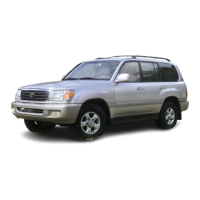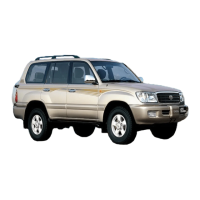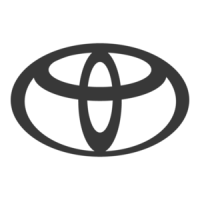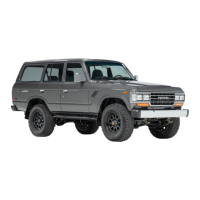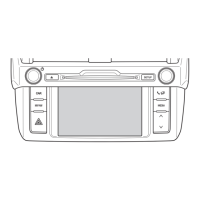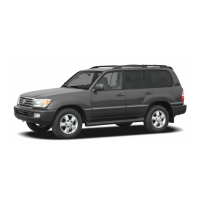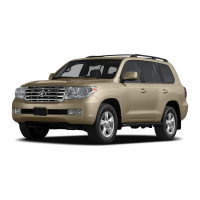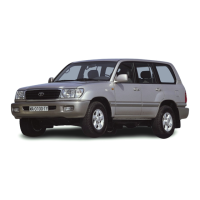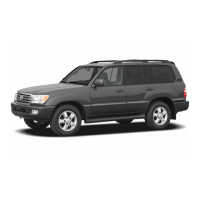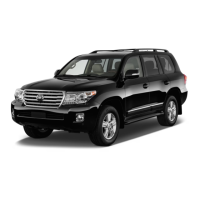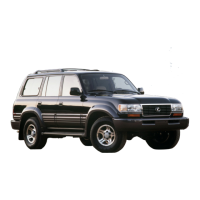
Do you have a question about the Toyota Land Cruiser 1996 and is the answer not in the manual?
| Brand | Toyota |
|---|---|
| Model | Land Cruiser 1996 |
| Category | Automobile |
| Language | English |
Introduces the overview of instruments and controls, detailing specific sub-sections.
Provides a visual guide to the various components of the instrument panel.
Details the layout and components of the instrument cluster, including gauges and lights.
Explains the meaning of various indicator lights and symbols found on the instrument panel.
Covers the operation and features related to vehicle keys and doors.
Details the function and usage of master and subkeys, and key number plate.
Explains the procedures for locking and unlocking side doors using key or power switch.
Details the operation of power windows on the driver's and passenger's doors.
Explains the operation of side windows and the window lock feature.
Describes how to open, close, and secure the back door, including child protection.
Provides instructions on how to open and close the vehicle's hood.
Details the procedure for opening and closing the fuel filler door and cap.
Explains the operation of the electric moon roof, including sliding and tilting functions.
Covers adjustments and safety features for seats, seat belts, steering wheel, and mirrors.
Discusses proper seating posture, seat adjustment precautions, and seat belt usage.
Provides crucial safety precautions for adjusting front seats while the vehicle is in motion.
Details the steps for adjusting seat position and seatback angle on manual seats.
Explains how to adjust seat position, seatback angle, cushion angle, and lumbar support.
Covers precautions and procedures for operating rear seats, including folding and removal.
Details the adjustment and importance of head restraints for safety.
Explains seat belt usage, precautions, and care for different passenger types.
Instructions on how to adjust the steering wheel angle for optimal driving position.
Covers adjustment, power control, and folding of outside rear view mirrors.
Explains the function and use of the day-night lever on the inside rear view mirror.
Describes the use of vanity mirrors, including their illumination feature.
Covers the operation of headlights, turn signals, wipers, washers, and defoggers.
Details how to operate headlights, high/low beams, and turn signals.
Explains how to activate and use emergency flashers for hazard warnings.
Instructions on how to operate the personal light.
Instructions on adjusting the brightness of the instrument panel lights.
Explains the function of the ignition switch light.
Describes how to turn on interior lights and their operation with door status.
Covers the operation of windshield wipers and washer, including interval adjustment.
Explains the operation of the rear window wiper and washer system.
Details how to operate the rear window defogger to clear condensation.
Explains the function of various gauges, meters, and service reminder indicators.
Describes the fuel gauge operation and low fuel warning indicators.
Explains the engine coolant temperature gauge and indications of overheating.
Details the oil pressure gauge operation and warnings for low oil pressure.
Explains the voltmeter's function in indicating battery charge status.
Describes the tachometer for monitoring engine speed and preventing over-revving.
Explains the odometer for total distance and trip meter for measuring distances.
Lists service reminder indicators and their corresponding actions or checks.
Provides a procedure to check the functionality of various service reminder indicators.
Covers the ignition switch, transmission operation, and parking brake.
Explains the different positions of the ignition switch and steering lock mechanism.
Details the operation of the automatic transmission, including shift lock and driving modes.
Explains the operation of the four-wheel drive control lever and shifting procedures.
Describes the front and rear differential lock system for extreme conditions.
Instructions on how to set and release the parking brake.
Covers the operation, setting, and cancellation of the cruise control system.
Details the operation of the car audio system and air conditioning controls.
Provides tips for operating the car audio system, including radio and tape player functions.
Instructions on adjusting the power antenna height.
Explains the controls and operation of the AM-FM radio and cassette player.
Details the operation of the audio system, including radio, cassette, and CD player functions.
Covers the operation of the air conditioning system, including controls and functions.
Explains the operation of the heater system, including temperature and fan speed controls.
Details the operation of the rear heater controls.
Instructions on opening and closing the side air vents.
Instructions on opening and closing the lower air vent.
Covers other equipment like the clock, cigarette lighter, glovebox, and luggage cover.
Explains how to set and reset the digital clock.
Details the operation of the cigarette lighter and how to remove the ashtray.
Instructions on opening and locking the glovebox door.
Explains how to use and remove the luggage cover.
Instructions on using tie-down hooks to secure luggage.
Precautions and instructions for placing floor mats correctly to avoid interference.
Provides essential precautions for operating the vehicle off-road to ensure safety.
Offers tips for the initial break-in period to ensure long vehicle life and fuel economy.
Details the required fuel type, octane number, and tank capacity.
Advises on checking vehicle registration and fuel availability when driving abroad.
Explains the function of the catalytic converter and precautions to prevent damage.
Details safety precautions related to engine exhaust fumes.
Explains normal engine oil consumption and factors affecting it.
Describes the tandem master cylinder brake system and brake booster function.
Explains the warning noise indicating worn brake pads that need replacement.
Provides guidelines for safely stowing luggage to maintain vehicle balance and prevent injury.
Describes the rear step bumper's purpose and safety precautions for its use.
Explains the vehicle identification number (VIN) and its location.
Details the purpose and importance of theft prevention labels on the vehicle.
Warns against modifying the suspension or chassis, which can affect handling.
Discusses different tire types (summer, all-season) and their characteristics.
Lists pre-start checks and procedures before operating the vehicle.
Provides step-by-step instructions for starting the vehicle's engine.
Offers advice for driving safely in various conditions like hills, wet roads, and traffic.
Outlines precautions for driving the vehicle off-road to ensure safety and prevent damage.
Provides tips for safe driving and vehicle preparation during winter conditions.
Covers essential information and precautions for towing a trailer safely.
Offers tips on fuel efficiency and vehicle maintenance for longevity.
Provides troubleshooting steps for when the vehicle fails to start.
Outlines procedures to follow if the engine stalls while the vehicle is in motion.
Details steps to take if the vehicle's engine overheats, including safety precautions.
Provides instructions and safety precautions for changing a flat tire.
Explains methods and precautions for towing the vehicle in an emergency.
Describes how to use the shift lock override button if the selector lever is stuck in "P".
Offers advice on what to do if you lose your vehicle keys.
Explains common causes of corrosion and provides guidelines for prevention.
Details proper methods for washing and waxing the vehicle to maintain its finish.
Provides instructions for cleaning the vehicle's interior, including carpets, vinyl, and leather.
Outlines the importance of regular maintenance for vehicle performance and longevity.
Lists general maintenance items to be performed periodically for vehicle operation.
Provides clues and signs that indicate a need for vehicle inspection or repair.
Introduces the do-it-yourself maintenance section, covering engine, fuses, and parts.
Provides a diagram and labels for the components in the engine compartment.
Shows the location of fuse boxes and identifies different types of fuses.
Offers essential safety precautions to follow when performing vehicle maintenance yourself.
Covers checks for engine oil, coolant, brake fluid, power steering fluid, and tires.
Provides detailed steps and precautions for checking and adding engine oil.
Explains how to check the engine coolant level and the importance of using the correct coolant.
Details how to check the brake fluid level and the significance of keeping it filled.
Instructions on checking and adding power steering fluid, with related cautions.
Explains the importance of proper tire pressure and how to check it accurately.
Covers checking tread wear indicators and the process of replacing tires.
Provides guidance on tire rotation to equalize wear and extend tire life.
Advises on selecting and installing snow tires and chains for winter driving.
Explains when to replace wheels and the importance of selecting correct replacements.
Offers precautions for handling and maintaining aluminum wheels.
Covers battery checks, fuse replacement, and headlight aim adjustment.
Explains how to check battery condition using fluid levels or a hydrometer.
Details safety precautions and procedures for recharging the vehicle battery.
Guides on checking blown fuses and procedures for replacing them.
Explains how to check and replace fusible links if electrical components fail.
Instructions on adding washer fluid, including the correct type to use.
Details how to check and adjust the headlight aim for proper road illumination.
Provides a table and instructions for replacing various vehicle light bulbs.
Lists the vehicle's overall dimensions, wheelbase, and weight capacities.
Provides engine specifications, including model, type, bore, stroke, and displacement.
Details fuel type, octane rating, and tank capacity requirements.
Covers engine valve clearance, spark plug gap, drive belt tension, and fluid capacities.
Lists tire sizes, pressures, wheel nut torque, and wheel sizes.
Provides a detailed list of fuse types, ratings, and the circuits they control.
Explains how to report vehicle safety defects to NHTSA and Toyota.
Details the DOT quality grades for tires, including treadwear, traction, and temperature.
